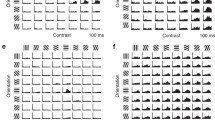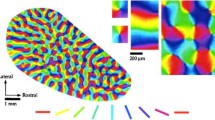Abstract
Blasdel and Salama's sensory maps of orientation-selective edge detectors in the monkey striate cortex can be reduced to an idealized scheme in which orientation hypercolumns of the d- and l-type occur in alternating sequence (Fig. 1). This scheme resolves the apparent contradiction between linear and circular arrangements of successive edge directions in earlier accounts. The actual configuration of hypercolumns is in register with two possible templates for the self-organization of orientation selectivity: the isometric cytochrome oxidase blobs of the colour system, and the anisometric slabs of the ocular dominance system. The centers of the hypercolumns coincide with the blobs. Simulation of cortical self-organization shows this co-incidence even in the absence of template-specific interactions. However, blobs and slabs are symmetrical to these centers, and therefore no templates for the asymmetrical distribution of preferred orientation in the hypercolumns. The present simulation derives the pre-natal formation of an initial scheme from a hypothetical gradient of nervous activity. Post-natal formation, or maturation, of this scheme is achieved by visual experience. Simulation of corresponding interactions between simultaneously activated neurons illustrates both the gain in orientation selectivity (Figs. 2 and 3), and the optimization of farfield diversity and nearfield conformity (Figs. 4 and 5). The results are compatible with the actual distribution of blob-centered d- and l-hypercolumns, iso-orientation modules and orientation fractures in the monkey. A surprisingly similar distribution of blobless d- and l-hypercolumns is expected in the absence of the colour system. Applied to the apparently blobless cortex of the cat, the scheme explains the modulation of deoxyglucose uptake along the iso-orientation bands in a report of Löwel, Freeman, and Singer.
Similar content being viewed by others
References
Blasdel GG, Salama G (1986) Voltage-sensitive dyes reveal a modular organization in monkey striate cortex. Nature 321:579–585
Braitenberg V (1985) Charting the visual cortex. In: Peters A, Jones EG (eds) Cerebral cortex, vol. 3. Plenum Press, New York London, pp 379–414
Cowan JD, Malsburg C v. d. (1985) A proposed mechanism for the origin and development of iso-orientation columns. In: Rose D, Dobson VG (eds) Models of the visual cortex. Wiley, New York, pp 462–472
Dow BM, Bauer R (1984) Retinotopy and orientation columns in the monkey: a new model. Biol Cybern 49:189–200
Elsdale T, Wasoff F (1976) Fibroblast cultures and dermatoglyphics: the topology of two planar patterns. Wilh Roux Arch 180:121–147
Frégnac Y, Imbert M (1984) Development of neuronal selectivity in primary visual cortex of cat. Physiol Rev 64:325–434
Götz KG (1987) Do “d-blob” and “l-blob” hypercolumns tessellate the monkey visual cortex? Biol Cybern 56:107–109
Grinvald A, Lieke E, Frostig RD, Gilbert CD, Wiesel TN (1986) Functional architecture of cortex revealed by optical imaging of intrinsic signals. Nature 324:361–364
Horton JC, Hubel DH (1981) Regular patchy distribution of cytochrome oxidase staining in primary visual cortex of macaque monkey. Nature 292:762–764
Hubel DH, Wiesel TN (1974a) Sequence regularity and geometry of orientation columns in the monkey striate cortex. J Comp Neurol 158:267–294
Hubel DH, Wiesel TN (1974b) Uniformity of monkey striate cortex: a parallel relationship between field size, scatter, and magnification factor. J Comp Neurol 158:295–306
Hubel DH, Wiesel TN (1977) Functional architecture of macaque monkey visual cortex. Proc R Soc Lond B 198:1–59
Hubel DH, Wiesel TN, Stryker MP (1978) Anatomical demonstration of orientation columns in macaque monkey. J Comp Neurol 177:361–379
Humphrey AL, Hendrickson AE (1983) Background and stimulus-induced patterns of high metabolic activity in the visual cortex (area 17) of the squirrel and macaque monkey. J Neurosci 3:345–358
Leventhal AG (1985) Retinal design of the striate cortex. In: Rose D, Dobson VG (eds) Models of the visual cortex. Wiley, New York, pp 380–389
Linsker R (1986a) From basic network principles to neural architecture: emergence of spatial-opponent cells. Proc Natl Acad Sci 83: 7508–7512
Linsker R (1986b) From basic network principles to neural architecture: emergence of orientation-selective cells. Proc Natl Acad Sci 83:8390–8394
Linsker R (1986c) From basic network principles to neural architecture: emergence of orientation columns. Proc Natl Acad Sci 83:8779–8783
Livingstone MS, Hubel DH (1984a) Anatomy and physiology of a color system in the primate visual cortex. J Neurosci 4:309–356
Livingstone MS, Hubel DH (1984b) Specificity of intrinsic connections in primate primary visual cortex. J Neurosci 4:2830–2835
Löwel S, Freeman B, Singer W (1987) Topographic organization of the orientation column system in large flat-mounts of the cat visual cortex: q 2-deoxyglucose study. J Comp Neurol 255:401–415
Malsburg C v.d. (1973) Self-organization of orientation sensitive cells in the striate cortex. Kybernetik 14:85–100
Malsburg C v. d., Cowan JD (1982) Outline of a theory for the ontogenesis of iso-orientation domains in visual cortex. Biol Cybern 45:49–56
Meinhardt H (1986) Hierarchical inductions of cell states: a model for segmentation in Drosophila. J Cell Sci [Suppl] 4:357–381
Mitchison GJ (1985) Does the striate cortex contain a system of oriented axons? In: Rose D, Dobson VG (eds) Models of the visual cortex. Wiley, New York, pp 443–451
Mullikin WH, Jones JP, Palmer L (1984) Receptive-field properties and laminar distribution of X-like and Y-like simple cells in cat area 17. J Neurophysiol 52:350–371
Price DJ (1985) Patterns of cytochrome oxidase activity in areas 17, 18 and 19 of the visual cortex of cats and kittens. Exp Brain Res 58: 125–133
Schwartz EL (1977) Afferent geometry in the primate visual cortex and the generation of neuronal trigger features. Biol Cybern 28:1–14
Seelen W v. (1970) Zur Informationsverarbeitung im visuellen System der Wirbeltiere. II. Kybernetik 7: 89–106
Soodak RE (1987) The retinal ganglion cell mosaic defines orientation columns in striate cortex. Proc. Natl Acad Sci 84:3936–3940
Swindale NV (1982) A model for the formation of orientation columns. Proc R Soc Lond B 215:211–230
Swindale NV (1985) Iso-orientation domains and their relationship with cytochrome oxidase patches. In: Rose D, Dobson VG (eds) Models of the visual cortex. Wiley, New York, pp 452–461
Author information
Authors and Affiliations
Rights and permissions
About this article
Cite this article
Götz, K.G. Cortical templates for the self-organization of orientation-specific d- and l-hypercolumns in monkeys and cats. Biol. Cybern. 58, 213–223 (1988). https://doi.org/10.1007/BF00364127
Received:
Issue Date:
DOI: https://doi.org/10.1007/BF00364127




